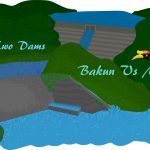“Benak” adalah bahasa ibunda untuk tidal bore di Sarawak. Mari melayari Benak di Sungai Batang Lupar!
Tidal Bore (gelombang pasang surut) adalah keajaiban semula jadi. Tidak semua pantai mempunyai gelombang pasang surut, mari mencari tahu bagaimana pasang surut ini unik dan bagaimana ia terbentuk.
Bagaimanapun, festival Tidal Bore (Pesta Benak) adalah dekat tarikhnya, selamat datang ke pekan Sri Aman untuk menyaksikan festival besar ini pada 3 hingga 5 November 2017.
Matahari, Bulan, Bumi dan Air Pasang Surut
Di seluruh dunia paras laut naik dan turun setiap hari dengan pasang surut. Ia boleh berbeza-beza dari semasa ke semasa, dan biasanya dipengaruhi oleh pelbagai faktor seperti tarikan graviti dari badan planet yang penting seperti matahari dan bulan, sistem tekanan atmosfera, arah laut semasa, bathymetry dasar dasar laut dan putaran bumi itu sendiri.
Di tempat yang berbeza, paras laut berubah secara berbeza. Di Mediterranean, pasang surut kecil. Sepanjang bahagian-bahagian di Atlantik dan Pasifik pantai naik dan jatuh boleh melampau.
Air Pasang Surut terutamanya disebabkan oleh gabungan graviti tarikan matahari dan bulan berhubung dengan daya yang diciptakan oleh putaran bumi. Ini mewujudkan “jadual masa” yang boleh diramalkan untuk air pasang atau surut.
Adalah penting untuk memahami bahawa air sebenarnya adalah “badan longgar” dan ia mengalir secara bebas sebagai tindak balas kepada tenaga. Seperti semangkuk manik bulat, memiringkan mangkuk akan membuat manik bergerak bebas bertindak balas dan bergerak ke arah daya yang lebih besar yang bertindak di atasnya – graviti.
Setiap objek dengan jisim akan wujud interaksi graviti dengan jisim berdekatan. Matahari adalah planet terbesar dan paling berat dalam sistem solar, ia mempunyai tarikan graviti pada semua planet dan asteroid yang lain supaya semua bergerak dengan mantap di sekitarnya. Walau bagaimanapun, kerana jaraknya dari Bumi, dan Bumi mempunyai tarikan graviti sendiri yang lebih dekat dan lebih kuat berbanding dengan matahari, air Bumi tidak bergerak ke arah matahari.
Bumi mempunyai bulan yang juga mempunyai tarikan graviti pada air bumi.
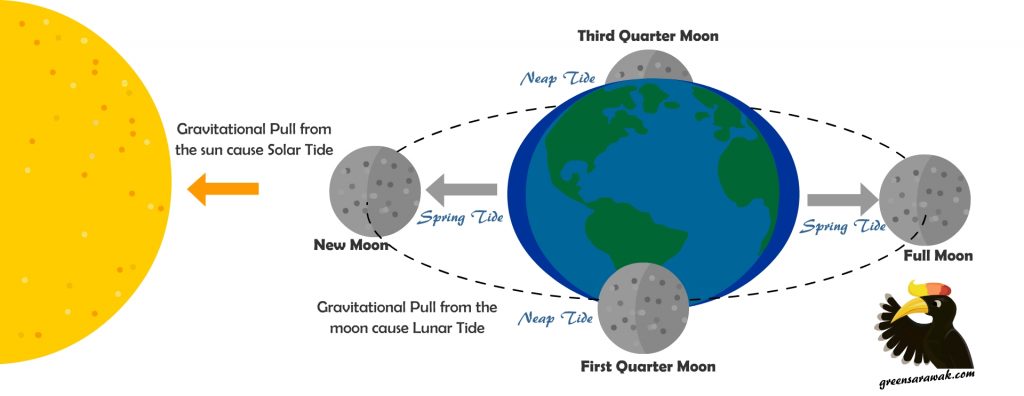
Lokasi relatif Matahari, Bulan dan Bumi akan menyebabkan air itu naik dan turun dengan sewajarnya. Tahap laut akan menjadi yang tertinggi (air pasang surut) apabila tarikan bulan dan matahari berada dalam barisan (pada bulan baru dan penuh)
Putaran bumi membuat bumi berbentuk oblate spheroid dengan kutub lebih rata dan khatulistiwa lebih membujur. Kesan ini terhadap jisim tanah juga memberi kesan kepada paras laut. Tahap laut adalah tertinggi di khatulistiwa daripada kutub kerana putaran bumi.
Gelombang Pasang Surut
Sebuah gelombang pasang surut adalah fenomena semulajadi yang jarang berlaku di mana arus air mengalir ke arah arus sungai masuk menghasilkan gelombang air yang bergerak di sepanjang sungai atau teluk yang sempit. Ia dilihat sebagai peningkatan aras dalam arus air dengan pembentukan gelombang depan yang mendadak.
Semua pasang surut terkenal di seluruh dunia mempunyai nama unik mereka:
- aegir (Trent River, England)
- benak (Batang River, Malaysia)
- mascaret (Seine River, France)
- pororoca (Amazon River, Brazil)
- silver dragon (Qiantang River, China)
Gelomabng Sungai Pasang Surut (Tidal Bore) kurang diramalkan daripada Pasang Surut air laut. Beberapa Tidal Bore boleh berlaku setiap hari, misalnya Benak di Batang Lupar Sarawak; sementara yang lain berlaku semasa ombak musim bunga (Pasang Surut paling kuat semasa bulan baru dan bulan penuh), cth. Pororoca Sungai Amazon.
Tidal Bore terbesar di dunia berlaku di sepanjang Sungai Qiantang di Hangzhou, China, di mana pasang naik hingga 30 kaki dan perjalanan sehingga 40 kilometer sejam. Tidal pasang terjadi pada musim semi dengan setiap bulan penuh, paling kuat pada musim gugur.
Tidal Bore in Asia
There are few rivers in Asia that tidal bore known to exist.
- Ganges–Brahmaputra, India and Bangladesh
- Indus River, Pakistan
- Sittaung River, Burma
- Qiantang River, China
- Batang Lupar or Lupar River, near Sri Aman, Malaysia.
- Batang Sadong or Sadong River, Sarawak, Malaysia.
- Bono, Kampar River, at Meranti Bay, Pelalawan, Indonesia.
- Styx River, Queensland
- Daly River, Northern Territory
Pembentukan Tidal Bore
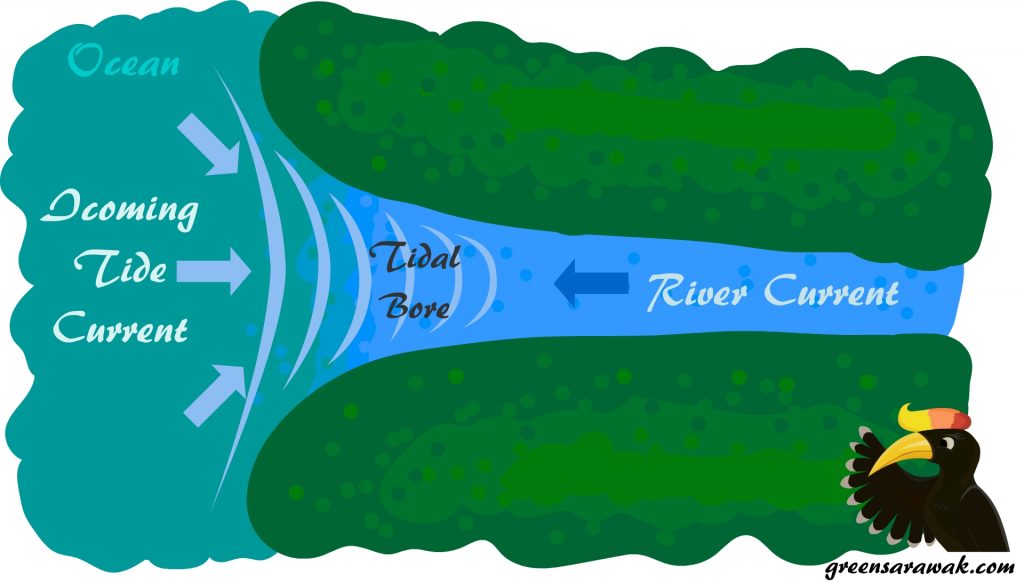
Perkembangan gelombang pasang surut bergantung kepada beberapa faktor:
- Arah angin – Gelombang pasang surut akan menjadi lebih kecil jika ia mengalir ke arah angin yang kuat akibat kesan tekanan udara ke atas air.
- Kedalaman sungai – sungai mesti cetek, muara (tempat di mana sungai air tawar memenuhi laut air masin) mestilah luas dan rata.
- Julat pasang surut – perbezaan antara pasang surut yang tertinggi dan terrendah mesti sekurang-kurangnya 6 meter (kira-kira 20 kaki).
- Kesan corong – cawangan muara yang lebih luas dan cetek sebagai corong yang menyalurkan air ke sungai yang sempit, di mana air naik untuk mengimbangi kemasukan volum. Kesan corong mengurangkan tempoh air banjir, menyebabkan penampilan peningkatan mendadak di paras air.
- Aktiviti manusia – Ia boleh mengubah atau menghapuskan gelombang pasang surut. mascaret Perancis adalah salah satu contoh yang terkenal. Ia telah dihapuskan melalui pengurusan sungai (terusan, empangan, pengairan, pengerukan) kerana ia dilihat sebagai bencana, menyebabkan kehilangan kapal dan memusnahkan dok.
Sebuah gelombang pasang surut adalah lonjakan pasang surut, yang bermaksud terdapat perubahan mendadak dalam kedalaman aliran. Peningkatan mendadak dalam kedalaman aliran disebut lonjakan positif, yang membawa kepada pembentukan tidal bore. Lonjakan positif kelihatan seperti lompatan hidraulik bergerak. Lebih lanjut mengenai lompatan hidraulik dijelaskan di bawah.
Apabila gelombang pasang surut terbentuk di muara, lonjakan positif akan stabil dan mengekalkan diri sendiri, dan dapat melakukan perjalanan ke hulu jarak jauh bergantung pada keadaan sempadan yang sesuai.
Types of tidal bore
A tidal bore may take on two basic forms:
- a single breaking wavefront with a roller, somewhat like a hydraulic jump. This usually happens in shallow water with smooth and gentle slope which creates a faster flow of the river current towards the sea. The fast flow is abruptly slowed (rapid deceleration) at the intense turbulent shock-wave-like front, creating an increase in height of water after the jump.
The hydraulic jump – when a faster flowing water meets an flow from opposite direction causing the flow to slow down and creating a slow moving turbulent flow that forms the advancing wave front of a tidal bore going upstream. - Undular bores which comprising a smooth wavefront followed by a train of secondary wave (whelps). Usually appears like a propagating ripple. It is happen in waters that is relatively deep and the change of elevation is small.
The Undular Bore: When the positive surge creates a standing wave pattern advancing by a undular bore front followed by a train of well-defined free-surface undulations (whelps).
The shape of the bore is a function of the surge Froude number. For Froude numbers between 1 and 1.3 to 1.5, the bore exhibits an undular profile. For larger Froude numbers, the surge has a breaking front. The energy is usually dissipated as a roller at the front.
The Roar of Tidal Bore
The tidal bore is usually associated with a roar of aggressive tidal wave, which can be heard from minutes to hours before the tidal bore appears (Sound travel faster than water waves) and even hours after the tidal bore. The low frequency roar rumble can travel far away. The roar is caused by the turbulence in the bore front and whelps and the sound of wave hiting against obstacles along the way.
The above video is an example showing the Roar of Benak. It is recorded with a stereo microphone at a fix volume. If you have a good pair of stereos, you might even hear the roar from far, and hear it sweep below your feet.
Tidal Bore of Sarawak – Benak
The Tidal Bore occurrence of Sarawak is greatly due to its geographic feature along the cost. At the Southern part of Sarawak, there is a huge funnel shaped coast between Kuching and Sibu.
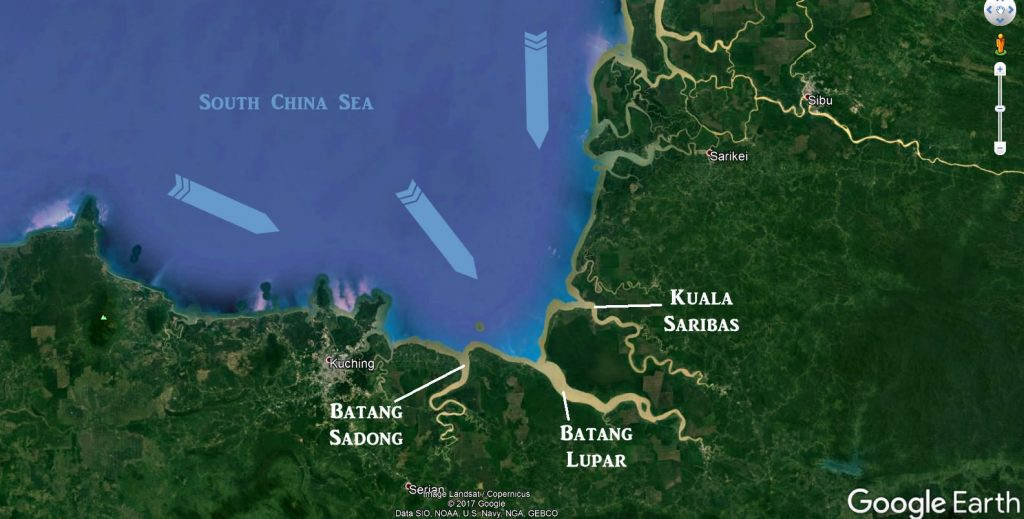
The tidal waves is greatly influenced by the funnel shaped coast, causing a great tidal range at the three rivers near the apex of the funnel. The three rivers are Batang Sadong, Batang Lupar and Kuala Saribas.
Out of the three, the Tidal bore occurance is known to occur at Batang Sadong and Batang Lupar due to its wide shallow river. The Batang Lupar tidal bore being the famous for frequent tidal bore ocurrance, in fact two times a day during higher tide peaks, with two peaks a month during Full Moon and New Moon.
The bathymetry (topography of the underwater land mass) is unique, allowing the great tidal force transmitted all the way deep into the inland river. It is wide, mostly straight and shallow all the way to pulau seduku, a lone island in the center of the Batang Lupar river.
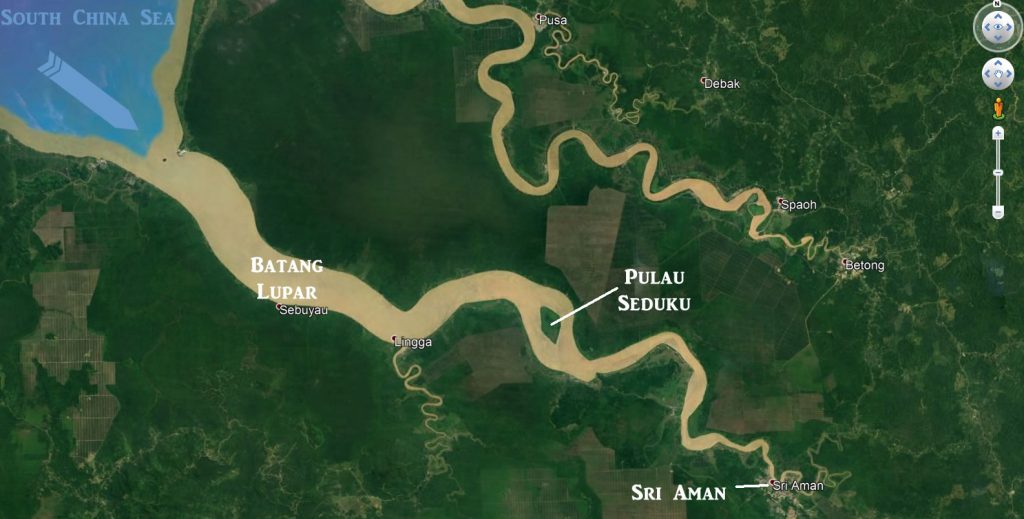

The Sri Aman Tidal Bore – Benak, usually start to appear at Pulau Seduku, Bakong and travel up to 45 km passing Sri Aman Town till it ended somewhere at Berangan. Some local also believe the movement of the bore ended as far as Engkelili, 47 km from Sri Aman Town.
The Taman Panorama Benak or the Tidal Bore Park by the River in Sri Aman is designed specifically for visitors to have a good view of the incoming Tidal Bore at an angle or near 45 degrees from your left. It is located at the Historic Fort Alice ( built by Charles Brooke in 1864) site. The park also won an international honour at the Arcasia Award for Architecture for its unique spiral walkways designs. The Architect, Mike Boon says the spiral form of the walkways resembling the midin or paku (local wild fern), which wind down a seven meters slop gracefully, with a sunken courtyard allowing natural light, cross-ventilation and a sweeping view of the Batang Lupar river. This landmark building is the home of the Anual Tidal Bore Festival – Pesta Benak.
Pesta Benak – The Annual Tidal Bore Festival of Sri Aman
Every year, in the peaceful town of Sri Aman, there is a festival that is Sarawak’s Iconic events celebrated on a grand scale. It is the Pesta Benak or the Annual Tidal Bore Festival, that celebrated along the Batang Lupar riverfront of Sri Aman.
The dates of the festival is not fixed but rather according to the almanac calendar. The dates will fall on the month where the tidal range is the widest and will anticipating a perfect Tidal Bore occurrence. It is usually at the second half of the year.
During this three day event, people from near and far came and gather around the riverfront for celebrating the festival. Usually hotels and accommodations are fully booked months before the event.
The major events consists of the Food and Cultural Bazaar, Performance Main Stage and Ragata (Water Sports).
The Food and Cultural Bazaar is located along the riverfront and streets around the downtown area where various local foods and handicraft stall booths are setup.
The performance stage will be location where the opening ceremony, cultural dance and performance takes place. Occasional local and national renowned artist come and perform on the stage. Mr Benak title will be given to the best body building contet while Ms Benak is awarded to the best in beauty pageant contest.
The highlight of the Benak Festival is nevertheless the Water Sports event, which known as Ragata. Participants from local an international come and compete in the water sports including Long Boat padding competition, Jet ski and pump ski races, Tidal Bore Surfing. The peak of the events is when comes to Tidal Bore Surfing where participants are arrange in rows and awaiting to catch the Benak. The one who manage to catch and surf perfectly with the Tidal Bore to the finish line will be the winner.
A snapshot of videos on the Pesta Benak 2016.
More Photos on the Last Pesta Benak Event in 2016 at : https://360tour.asia/pesta-benak-sri-aman-2016-the-tidal-bore-festival/
This year Pesta Benak will be held on November 3, 2017 – November 5, 2017. Stay tuned and book your seats early to witness this natural phenomena with many others around the world.
According to tide-forecast.com the tide level for the three days are as follows.
November 3, 2017 (Friday)
- Low Tide, November 2, 2017 10:04 PM : 1.60 meters
- High Tide, November 3, 2017 3:48 AM : 4.96 metres
- Low Tide, November 3, 2017 10:31 AM : 1.26 metres
- High Tide, November 3, 2017 4:20 PM : 5.01 metres
November 4, 2017 (Saturday) – Full Moon
- Low Tide, November 3, 2017 10:52 PM : 1.49 meters
- High Tide, November 4, 2017 4:26 AM : 5.11 metres
- Low Tide, November 4, 2017 11:13 AM : 0.87 metres
- High Tide, November 4, 2017 5:07 PM : 5.30 metres
November 5, 2017 (Sunday)
- Low Tide, November 4, 2017 11:38 PM : 1.44 meters
- High Tide, November 5, 2017 5:04 AM : 5.22 metres
- Low Tide, November 5, 2017 11:54 AM : 0.55 metres
- High Tide, November 5, 2017 5:54 PM : 5.50 metres
It is based on a forecast from Kuching City nearby, the actual time for the Tidal Bore might slightly varies.So be there early.
The High Tide on the evening of November 4 and 5 will be the most anticipated Tidal Bore occurrence. The great tidal range will create a perfect tidal bore for Tidal Bore Surfing.
Although there is other High Tides where tidal bore can occur but it will be either small bore or it is dark and not safe to surf in the dark.
The Effects of Tidal Bore
Tidal bore not all are fun and love by many. Some bring benefit but some cause disasters.
The Benefit of Tidal Bore:
- Tidal bore furious bore formation have the power to crush material , stir and mix organic matters, create good aeration and wash nutrients upstream from the sea towards the deep inland. These tidal bores usually started from the estuary where the salty sea water meets the fresh river water where many marine lifeforms breed and flourish. It is essential to the survival of the unique ecosystem. The suspension of the muddy looking river can stay for a long time after the bore due to the ongoing current flow and underlying long lasting wave motion.
- Tidal Bore create an unique opportunity for water sports like Kayaking and Tidal Bore Surfing. It had known to promote ecotourism boost in areas with frequent Tidal Bores.
- Tidal Bore areas almost always happens in shallow rivers with wide tidal range is large. The shallow rivers was not suitable for larger boats and ships during low tides but are suitable when the tides was high. Tidal bore marks the changing of the tides and a usually low level river will be fill with waters after the tidal bore, allowing passage of bigger ships. This also allow upstream travel to deeper inland, connecting more river side village inland.
- Tidal bore will prevent stagnation of water at the river and wash away rubbish at the side of the river banks hence have its role to frequently destroy breeding grounds for vectors like mosquitoes.
The Problems with Tidal Bore:
- Tidal bores is also known to destroy ships and docks along the river banks. The force of a tidal bore can some equivalent to a surge of mini tsunami , uplifting non secure boats against the shore and trip over smaller boats. It can also cause erosion below the docks and destroy their foundation. It also affects the shipping and navigation of boats at the estuary and river.
- Loss of life is not uncommon in places with massive destructive tidal bore, especially to the unsuspecting on looker at the side of the banks. Tidal bores wash away victims with their vigorous current and turbulence flow.
- Some tidal bore occurrence is not predictable, which increase risk of unawareness among user of the river.
- Soil erosion is not uncommon in along the areas of tidal bore. Trees are seen up rooted by the tidal bore.
Tidal bore is a natural wonder. Its only happens if certain criteria are met. It can bring benefit and also destruction at the same time. Better understanding of the formation of the tidal bore allow us to predict its occurrence more accurately and we can be aware of the safety concern of shipping and people lives at stake at the Tidal Bore prone rivers.
The Tidal Bore festival is just a few days away. Lets surf the Benak !





